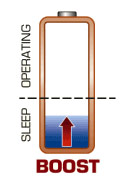Li-ion batteries contain a protection circuit that shields the battery against abuse. This important safeguard has the disadvantage of turning the battery off if over-discharged. Storing a discharged battery for any length of time can do this. The self-discharge during storage gradually lowers the voltage of the already discharged battery and the protection circuit cuts off between 2.20 and 2.90V/cell.
Some battery chargers and analyzers, including those made by Cadex, feature a wake-up feature or “boost” to allow charging batteries that have fallen asleep. Without this feature, a charger would read these batteries as unserviceable and the packs are discarded. The boost feature applies a small charge current to activate the protection circuit to 2.20–2.90V/ cell, at which point a normal charge commences. Caution should be applied not to boost
lithium-based batteries back to life that have dwelled below 1.5V/cell for a week or longer.Copper shunts may have formed inside the cells that can lead to a partial or total electrical short. If trying to recharge, such a damaged cell might become unstable, causing excessive heat or showing other anomalies.
| |
Figure 1: Sleep mode of a lithium-ion battery
Some over-discharged batteries can be “boosted” to life again. Discard pack if the voltage does not rise to a normal level within a minute while on boost. |
A study of failed batteries done by Cadex reveals that three out of ten batteries die due to over-discharge. If serviced within a year or so, batteries that have fallen asleep can be revived without noticeable loss on performance. Lack of service squanders many good batteries, so much so that 90 percent of returned batteries have no fault and can be reused. The cellular industry estimates the cost of needless
acer extensa 5220 battery replacement at $10 million a year. Refurbishing batteries has the added benefit of protecting the environment and keeping our planet green.





No comments:
Post a Comment